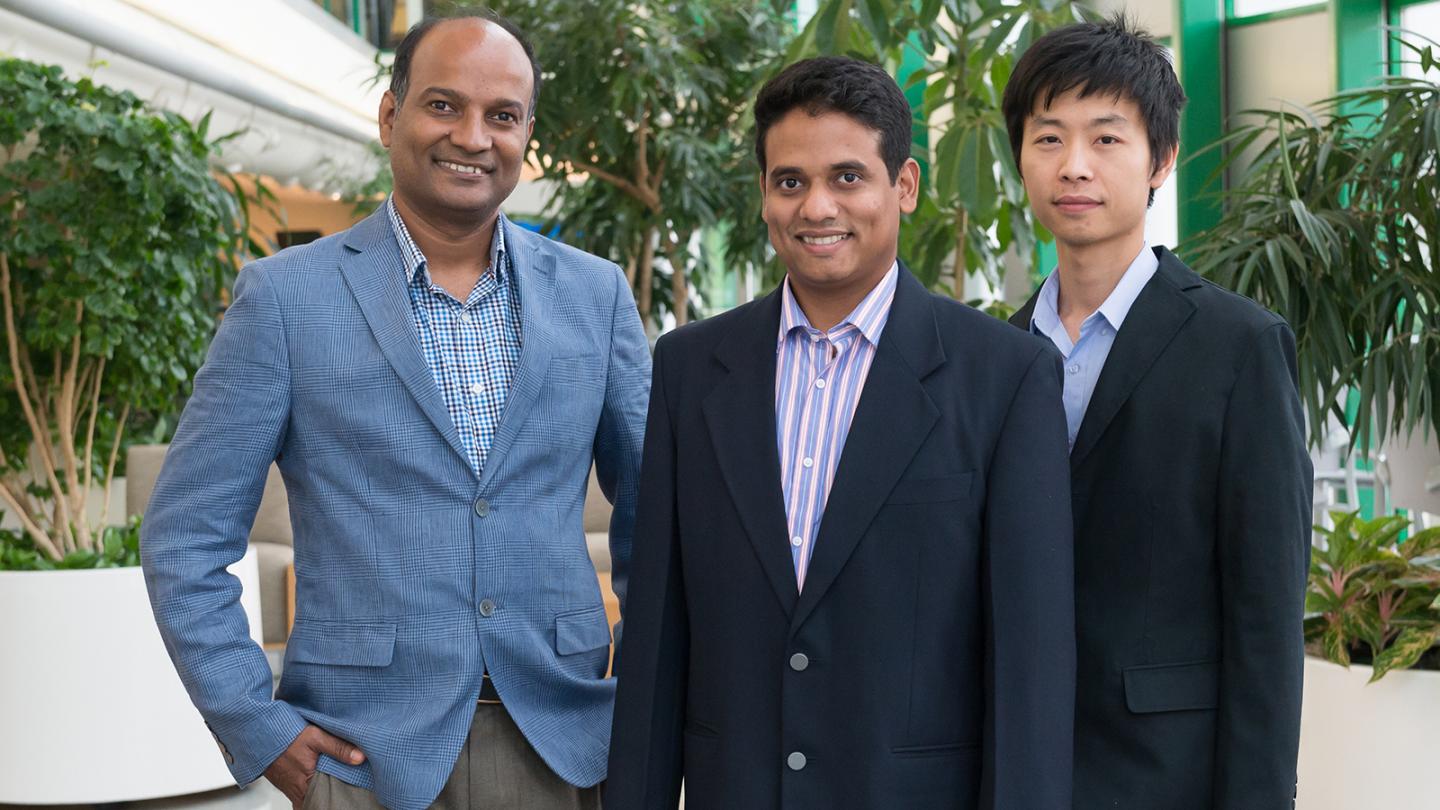
Principal investigator Subramanian Sankaranarayanan (left), and co-principal investigators Mathew Cherukara (center), Henry Chan (right) and Badri Narayanan (not pictured) are developing a new machine learning based software that will enable industry to more quickly and efficiently perform the molecular dynamics simulations they need to vet the performance of new materials for their products.
Discovering and designing new materials is frequently an expensive and time-intensive process. To speed it up and create new materials for everything from aeronautics to wind turbines, scientists have begun to rely on complex modeling and simulation platforms.
Thanks to a new grant from the U.S. Department of Energy's (DOE) Technology Commercialization Fund, researchers at DOE's Argonne National Laboratory and its industry partners will improve materials design and discovery by making materials modeling more efficient.
"There's a huge market potential for this kind of software. Thousands of people run molecular dynamics simulations but the ability to develop models that describe the underlying interactions between atoms and molecules is often a time consuming and tedious task." -- Subramanian Sankaranarayanan, scientist at the Center for Nanoscale Materials
Scientists at Argonne's Center for Nanoscale Materials (CNM), a DOE Office of Science User Facility, and their industry partners at Boeing and Sentient Science are working to accelerate and simplify a complicated materials modeling and simulation process that often takes years.
They are developing a new machine learning based framework called BLAST (Bridging Length/Timescales via Atomistic Simulation Toolkit). This software will enable companies to more quickly and efficiently perform the molecular dynamics simulations they need to vet the performance of new materials for their products.
"There's a huge market potential for this kind of software. Thousands of people run molecular dynamics simulations but the ability to develop models that describe the underlying interactions between atoms and molecules is often a time consuming and tedious task," said Subramanian Sankaranarayanan, the CNM scientist who heads the project.
The project will receive $150,000 from the DOE's Technology Commercialization Fund, with an additional $300,000 in total matching support from Boeing and Sentient Science. Boeing and Sentient Science were selected as partners because they offer Argonne scientists the opportunity to model two very different classes of materials as rigorous tests for their software. Boeing is interested in polymers and other soft materials, while Sentient Science's needs fall on the opposite end of the hardness spectrum, to metals, oxides and alloys.
Boeing expects the software to significantly impact its simulation of polymeric materials, especially epoxy thermostat resins that often serve as the matrix of carbon fiber composites for aircraft components. These resins, representing an $8 billion annual market, are also widely used in the paint, adhesive, electronics and construction industries.
Researchers at Sentient Science are interested in more fully understanding the relationships between structure, process and properties in steel alloys. In one example, researchers hope to understand and predict premature bearing failures in wind turbine gearboxes. Most failures in wind turbine bearings can be attributed to micro-structural alterations that originate at the atomic scale.
"To attain digital representation of materials and component behavior throughout the product lifecycle, the key is an accurate quantitative description of the relationships between processing, microstructures and material properties," said Harpal Singh, materials research scientist at Sentient Science. "Sentient Science will leverage this technology to model the properties of inorganic materials as an input for their DigitalClone software that predicts the life expectancy of complex mechanical systems in the wind energy, aerospace and rail industries."
The machine learning software that Argonne will design for both companies aims to learn to capture interactions between atoms and molecules in a range of material systems.
"Going from one metal to another metal, say, aluminum to copper, the functional form of the model that describes the interaction between atoms can remain the same. What will change are the parameters. Those parameters need to be determined," said Henry Chan, CNM postdoctoral appointee, co-principal investigator and one of the principal developers of this project.
Different functional forms of the modeling framework will be needed to meet the materials development needs of the two companies. "The way you describe interactions of molecules in polymeric materials is going to be very different from interactions of atoms in metals," said CNM scientist and co-principal investigator Mathew Cherukara.
The goal is to develop a user-friendly framework that automates the process of model development for any material of choice. Research and development specialists will describe the properties of the material that interests them, then the software will calculate an optimal solution. "And it will do that not in several years but in a matter of months, weeks or even days," Sankaranarayanan said.
In addition to the CNM, two other DOE Office of Science User Facilities at Argonne -- the Advanced Photon Source (APS) and the Argonne Leadership Computing Facility (ALCF) -- will generate large amounts of data that the team will use to optimize its software. The ultra-bright X-ray beams of the APS will reveal the molecular and atomic structures of the target materials. Supercomputers at the ALCF, the CNM and other high performance computing resources at Argonne's Laboratory Computing Resource Center can produce the highly accurate but computationally expensive quantum calculations that provide similar insights about the nanoscale interactions of the target systems.
The Argonne software will apply machine learning to both the experimental and theoretical data to train their numerical models to understand the behavior of as many different molecular interaction scenarios as possible.
"If you want a predictive model that performs well across a range of different manufacturing conditions, you require a rigorous data intensive training procedure that can't be done on small computers," Sankaranarayanan said. ?"You want to take advantage of high-performance computing."
EurekAlert!, the online, global news service operated by AAAS, the science society: https://www.eurekalert.org/pub_releases/2018-12/dnl-btt120418.php